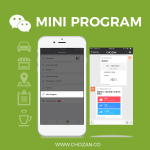With over 938 million monthly active users by the first quarter of 2017, WeChat is the most important social media platform in China. WeChat is no longer a choice but a necessity for luxury brands that want to sustain their growth in China.
In early January, 2017, WeChat officially launched its Mini Program platform. Although over 2,000 mini programs were launched at the start, the market seemed reluctant to accept them and questioned their necessity.
After a 2-month trial, WeChat revamped them to improve their performance, expand their applications and gain user confidence.
We’ve already witnessed several large brands stepping into Mini Program marketing, including Swarovski and Longchamp. Will this be the next move for luxury brands marketing on WeChat? Can mini programs reshape luxury retailing in China?
Here are the ways we think businesses will be using mini programs in the next year.
1. Using store mini programs to display offline store information and distribute cards or coupons
At the end of April, WeChat launched a new mini program feature called the “Store Mini Program (门店小程序)” which shows users basic information about an offline store, similar to a virtual business card.
However, it’s noteworthy that, despite its name, it’s not currently a mini program but a feature related to mini programs. With this feature, luxury brands that already have their official accounts can set up their store mini programs quickly using their WeChat account backstage without further programming.
Brands can display basic store information, including the store name, address, opening hours, contact phone number and store photos.
↑ Example of a store mini program.
Beginning in early May, store mini programs had the ability to distribute membership cards, coupons and vouchers to customers. What should be pointed out is that currently, each store mini program can only distribute one type of card or coupon. Branches in the same chain are considered different stores and can distribute different cards and coupons from other branches.
Because it’s already common practice for luxury brands to distribute cards and coupons to boost sales, this feature is helpful. On China’s online Valentine’s Day, May 20th (or “520” as the holiday is known in China—in Chinese, “520” is also a homophone for “I love you”), Coach released a gift voucher worth 520 RMB, which users could use when spending 3,800 RMB or above from May 16th to 21st on Coach’s official website or in designated offline stores.
Store mini programs build a more effective online-to-offline tunnel for luxury brands, especially when they want to boost sales in offline stores. It’s a good idea to upload photos of the latest promoted products and campaign posters in the store’s mini program. This provides customers with quick and clear product references.
In a separate section, add an interface to allow customers to collect membership cards and vouchers. This creates strong incentives for customers to visit the store and make purchases.
2. Using the “Mini programs nearby” section to drive traffic to offline stores
In early May, WeChat officially released the “Nearby mini programs (附近的小程序)” function. This function allows brands with physical stores and offline locations to display their mini programs or store mini programs in the “Mini programs nearby” section of the mini program homepage.
When users are in the vicinity of the brand’s location, mini programs for nearby businesses show up there, helping merchants to reach their potential customers more easily.
Imagine this scene: A customer is shopping in a large shopping mall. She stops and takes out her smartphone to check where she can buy a luxury bag. Instead of launching a map, she opens WeChat and goes directly to the “Mini programs nearby” section. Before she decides which store to visit, she can look through all the mini programs nearby and check out the products and campaign information displayed.
“Mini programs nearby” plays a significant role in connecting online customers with offline stores. If mini programs and store mini programs are a store’s virtual business card, then this location-based function is the tool that puts them into customers’ pockets so they can be seen by more people, thus increasing brand awareness as well as driving traffic and sales.
3. Using mini programs to build an e-commerce platform
For brands that have entered the Chinese market, they’ve either established their own official e-commerce platform or opened their online store on third-party e-commerce platforms like Taobao, JD.com, etc. However, both practices have their drawbacks.
Building an official e-commerce platform is much more time – and cost-consuming. On third party e-commerce platforms, brands face more restrictions and pay expensive deposit and management fees.
This, and WeChat’s huge user base, are why many marketers have already turned to WeChat. Many have been trying for a long time to figure out how to sell on WeChat directly. With the emergence of mini programs, luxury brands now have another option because of the low development costs and integration with WeChat Pay and the “Cards and Offers” function. Moreover, since mini programs are a built-in function in WeChat, stable traffic can be ensured.
Lane Crawford is a fashion retailing company with specialty stores selling designer label luxury goods in Hong Kong and mainland China. It officially launched its own mini program, “Shopping in Lane Crawford (连卡佛购物)”, as an e-commerce platform in mid-May. All the items are sorted into three sections: new products, item category and brands so that users can locate the product they want easily.
After customers find the item, they can purchase it directly using the mini program. Lane Crawford also incorporates its membership services into its mini program, encouraging users to register for a Lane Crawford membership or bind their membership account before purchasing.
Swarovski launched its mini program on Mother’s Day this year together with its online campaign. The jewelry brand’s mini program also functions like an e-commerce platform where users are encouraged to purchase the featured products directly. It’s a good idea to introduce some exclusive items for sale after luxury brands set up their e-commerce platform on their mini program so as to attract potential users.
4. Using mini programs to launch campaigns
Launching campaigns on social media to engage users and grow the brand’s influence is a common practice for luxury brands. Mini programs can be used as an alternative for luxury brands to launch giveaways, special offers as well as user-generated content (UGC) collection campaigns.
Compared to other campaign formats, like WeChat articles and H5 pages, mini programs may be more cost-effective and lasting. Nowadays, H5 pages are frequently used by luxury brands to launch promotional campaigns because of their visually pleasing format and attractive effects.
However, after the campaign is over, the original H5 page can no longer be used again since they were specifically designed for that campaign to show uniqueness. So H5 pages are more suitable for short-term campaigns.
↑On the occasion of “520”, Cartier designed an H5 page with its Amulette de Cartier series moving in five different labyrinths shaped like a flower, a heart, a four-leaf clover and the characters for “love” and “520”.
For campaigns that need to last longer or be held frequently, mini programs might be the best choice for luxury brands. For example, a luxury fashion brand can launch a UGC collection campaign with its mini program, encouraging its users to upload photos of themselves wearing newly-released clothes for this season. Other users can vote for the best outfit and the winner gets a prize. Using this format, the campaign can be launched each season with the same format, making it more cost-effective.
5. Using mini programs to live stream
With its unprecedented growth since 2016, live streaming has become another useful tool for luxury brands to expand their influence on social media and reach young customers. Many luxury brands have live streamed different events like fashion weeks and celebrity interviews on Weibo and live streaming apps like Yizhibo and Meipai. They have also cooperated with influential fashion KOLs and created the innovative “See now, buy now” mode, allowing viewers to reserve or buy certain items immediately while watching a live stream.
In fact, WeChat has already taken the first step to integrate live streaming with mini programs. On May 23rd, WeChat Open Class’s account (微信公开课) pushed a picture to its subscribers of a mini program code. After extracting the code in WeChat, users were directed to a mini program to watch a live stream of its offline event. Users were also allowed to participate in the interaction by leaving questions for the host.
Given the popularity of live streaming and the huge user base of WeChat, mini programs will become a strategic battlefield for brands once this function is officially released. With multiple functions combined in a single mini program, one day customers may make purchases directly while watching a live stream of a fashion show, providing another example of the “See now, buy now” function.
Disclaimer:
This article was originally published on Jing Daily, while ChoZan is the contributor.







